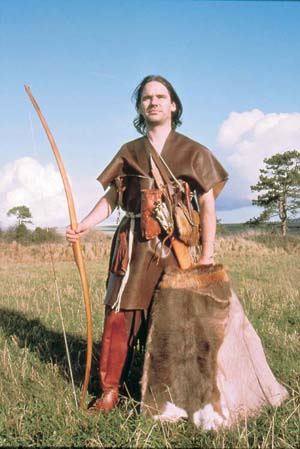

Above, two images of
Stonehenge. The image to the right shows how Stonehenge had
religious affiliations, particularly to the Druids.
Some theorize that the Druids built Stonehenge, while
others theorize that the Celts had built Stonehenge.
The strongest theory though, is that neither group built
the megalithic monuments.
Courtesy
of Wiki Commons and Rosemary Hill
Stonehenge has spiritual and
religious significance. About 240 people had special burials there
over a course of 500 years, from 2950 B.C to
2450 B.C. From the small number, it can be concluded that
these extravagant burials were only for special people, meaning
the common man was excluded from such a burial. One notable grave
is of a man ages of 35-45, with his left kneecap missing. He is
called the Amesbury Archer, because the man was buried with
arrows, five Beaker pots, two gold hair pins, copper knives from
France and Spain, and many other valuable goods(four boar's tusks,
122 flint tools,archer's braces, a cushion stone, & 18
arrowheads, to be exact). The cushion stone suggests that
alongside being an archer, he was also a blacksmith. The strontium
isotope ratio in the Archer's teeth show that he was born in the
Alps, and is a Swiss. There was a point in time when the archer
was dubbed King of Stonehenge. With that fact, many theorize
that Stonehenge was also a pilgrimage site where the wounded came
in hopes of being healed.
Timothy Darvill, an English
author, professor, and archaeologist, alongside Geoffrey
Wainwright, ex Chief Archaeologist of English Heritage, think that
Stonehenge do think that it was a site of healing. They believe
that the builders thought that the blue stones had magical healing
powers, similar to the concept of a healing spring. Archaeologist
Darvill says that there were even people who went to Stonehenge to
break off bits of rock, and later keep them as talismans. While
there were the special burials, there were also many ordinary
graves. Many of them were people who were not from the area, who,
like the Amesbury Archer, had come to heal their selves.

A depiction of the Amesbury
Archer
Courtesy
of Martin Green
From the year 2000,
Stonehenge has been used primarily to celebrate the summer
solstice.
LINKS
Ctrl+Mouse Click to open in new tab or right click open tab





